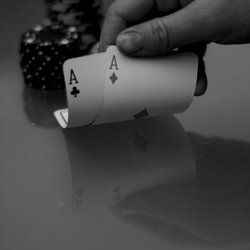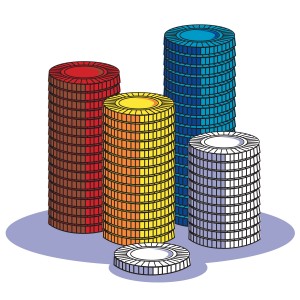Let me be honest with you. I am very hesitant to write this article. I wish you wouldn’t read it. Or if you do read it, DON’T play at my table. If you apply what you learn from this article, you will be in a position to start beating the majority of low limit games out there.
What is the single biggest mistake that beginning Pot Limit Omaha Hi Lo players make? Watching and playing the games for thousands of hands and hundreds of hours I think it is safe to say: playing too many starting hands.
In fact, this is where the great majority of your profit will come from in the game at the low limits. Many players will often put chips in the pot with hands that have a negative long-term expectation. By playing tighter yourself, you will gain a significant advantage. This is the fundamental secret of winning low limit Omaha high/low. It applies to all loose games. If you play the right amount of starting hands and apply some basic principles, you will be able to beat the low limit games without any special skills.
One hand or Six hands?
In hold’em, you are dealt two cards. You may use zero, one, or two cards from your hand to make your best hand. In Omaha high/low, you are dealt four cards. You must use two cards from your hand. The good news is that these cards may be different two for high and different two for low. In others words, you may select any two for high and any two for low. Clearly, there are possibilities. Imagine being dealt a hand with some cards: ABCD. How many two-hand combinations are there?
We can easily see that there are six two-card combinations:
AB
AC
AD
BC
BD
CD
This is crucial to realize. Contrary to appearances, you are really not playing a single hand. You are playing six two-card hands. Consequently, you want your cards to go well together in order to have the greatest number of strong two-hand combinations.
To illustrate, consider the most powerful starting hand in Pot Limit Omaha Hi Lo:
AdAh2d3h.
Consider the six two-card combinations:
1. Ad Ah
2. Ad 2d
3. Ad 3h
4. Ah 2d
5. Ah 3h
6. 2d 3h
Why is this hand so powerful? Even at a quick glance, it is evident that the hand has optimal possibilities in both directions, high and low. AA is top pair, and suited aces will always draw to nut flushes. A2 is the best starting low combination. 3 adds a low counterfeit protection. You therefore have the best possibilities to scoop the pot. Here we come to the guiding principle of winning hand selection in low limit Omaha high/low: play only hands that can scoop the pot. If you play to win only half the pot, as many players do at low limit, you are in effect cutting the pot odds in half. Needlessly to say, such a reduction will have a drastic impact on your bottom line.
Consider a hand that has “only” one card uncoordinated with others: QsQhJs2c. Which two card combinations can you play effectively?
1. QsQh
2. QsJs
3. QhJs
And… that’s it! Instead of six hands, you are effectively playing three. By having just one card that is not co-ordinated with the other three, you have cut your options in half. Most low limit players do not understand this idea and will play any four that contain at least two cards that they like (in effect, a lot of them seem to be playing hold’em with two cards that they like). Moreover, notice that the hand has no low possibilities. On a low flop (2 or 3 low cards), the hand will drop significantly in value. In general, playing for high only or low only is not a winning strategy. When entering a pot, you ought to have a well-coordinated hand that has an ability to win in both directions. (There are some exceptions to this rule (such A2XX), but we will not worry about them for the moment.)
Don’t Give Up Your Edge
In Theory of Poker, Sklansky states that “your edge comes not from holding better cards, but from play in situations where your opponents would play incorrectly if they had your hand and you had theirs” (Sklansky, 15). Remind yourself of this every time you are tempted to play poorly coordinated hands “just to see the flop”. Most of your edge will not come from making amazing moves or reads, but from your opponent’s poor hand selection. If you, however, join the loser’s club and start playing too loosely, your edge will rapidly disappear. Imagine your opponent holding your hand. Your goal is to play it at least as good or better than he or she would in your position. Don’t give up your edge for an added bit of excitement. Believe me, there will be plenty of excitement and winning when you play legitimate, positive EV hands.
Conclusion
Play to scoop! Moreover, keep an eye out on how well your cards are coordinated. Your edge will not come from wild raises or lucky cards. Most of it will come from playing better preflop than your opponents would with your cards. Do yourself a favour and win from the start.
In the next article, we will look at how to apply these general principles in selecting and playing specific starting hands.
Submit your review | |











